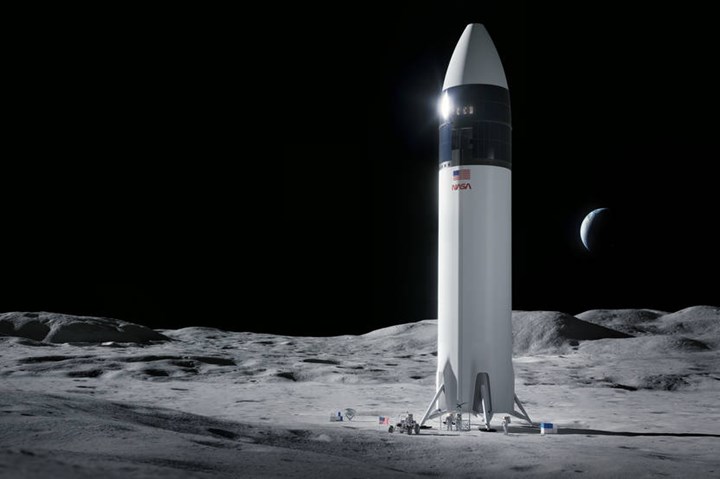NASA selects SpaceX to head human lander development for Artemis moon mission
HLS to act as final mode of transportation to take astronauts to the lunar surface for the Artemis program, with potential future travel to Mars and other destinations.

Illustration of SpaceX Starship human lander design that will carry the first NASA astronauts to the surface of the Moon under the Artemis program. Photo Credit: SpaceX
In preparation to send astronauts to explore more of the moon as part of the Artemis lunar exploration program, NASA has selected SpaceX (Hawthorne, Calif., U.S.) to continue development of the first commercial human lander that will safely carry the next two American astronauts to the lunar surface in 2024. At least one of those astronauts will make history as the first woman on the moon. Another goal of the Artemis program includes landing the first person of color on the lunar surface. SpaceX was one U.S. company chosen out of the three — including Dynetics (a Leidos company, Huntsville, Ala., U.S.) and Blue Origin (Kent, Wash., U.S.)—originally selected in April 2020 to design and develop human landing system (HLS) concepts for the program.
The agency’s Space Launch System (SLS) rocket will launch four astronauts aboard the Orion spacecraft for their multi-day journey to lunar orbit. There, two crew members will transfer to the SpaceX HLS for the final leg of their journey to the surface of the moon. After approximately a week exploring the surface, they will board the lander for their short trip back to orbit where they will return to Orion and their colleagues before heading back to Earth. The firm-fixed price, milestone-based contract total award value is $2.89 billion.
“With this award, NASA and our partners will complete the first crewed demonstration mission to the surface of the moon in the 21st century as the agency takes a step forward for women’s equality and long-term deep space exploration,” says Kathy Lueders, NASA’s associate administrator for Human Explorations and Operations Mission Directorate. “This critical step puts humanity on a path to sustainable lunar exploration and keeps our eyes on missions farther into the solar system, including Mars.”
SpaceX has been working closely with NASA experts during the HLS base period of performance to inform its lander design and ensure it meets NASA’s performance requirements and human spaceflight standards. A key tenet for safe systems, these agreed-upon standards range from areas of engineering, safety, health and medical technical areas.
“This is an exciting time for NASA and especially the Artemis team,” says Lisa Watson-Morgan, program manager for HLS at NASA’s Marshall Space Flight Center in Huntsville, Ala. “During the Apollo program, we proved that it is possible to do the seemingly impossible: land humans on the moon. By taking a collaborative approach in working with industry while leveraging NASA’s proven technical expertise and capabilities, we will return American astronauts to the moon’s surface once again, this time to explore new areas for longer periods of time.”
SpaceX’s HLS Starship, designed to land on the moon, leans on the company’s tested Raptor engines and flight heritage of the Falcon 1 and Dragon 9 vehicles. Starship includes a spacious cabin and two airlocks for astronaut moonwalks. The Starship architecture is intended to evolve to a fully reusable launch and landing system designed for travel to the moon, Mars and other destinations. While SpaceX CEO Elon Musk indicated the Starship’s design was to use stainless steel over carbon fiber back in 2019, the use for composites elsewhere might remain a possibility.
The HLS award is made under the Next Space Technologies for Exploration Partnerships (NextSTEP-2) Appendix H Broad Agency Announcement (BAA).
In parallel with executing the Appendix H award, NASA intends to implement a competitive procurement for sustainable crewed lunar surface transportation services that will provide human access to the lunar surface using the Gateway on a regularly recurring basis beyond the initial crewed demonstration mission.
With NASA’s Space Launch System rocket, Orion spacecraft, HLS and the Gateway lunar outpost, NASA and its commercial and international partners are returning to the moon for scientific discovery, economic benefits and inspiration for a new generation. Working with its partners throughout the Artemis program, the agency will fine-tune precision landing technologies and develop new mobility capabilities to enable exploration of new regions of the Moon. On the surface, the agency has proposed building a new habitat and rovers, testing new power systems and more. These and other innovations and advancements made under the Artemis program will ensure that NASA and its partners are ready for human exploration’s next big step — the exploration of Mars.
Related Content
Cryo-compressed hydrogen, the best solution for storage and refueling stations?
Cryomotive’s CRYOGAS solution claims the highest storage density, lowest refueling cost and widest operating range without H2 losses while using one-fifth the carbon fiber required in compressed gas tanks.
Read MorePlant tour: Albany Engineered Composites, Rochester, N.H., U.S.
Efficient, high-quality, well-controlled composites manufacturing at volume is the mantra for this 3D weaving specialist.
Read MorePlant tour: Middle River Aerostructure Systems, Baltimore, Md., U.S.
The historic Martin Aircraft factory is advancing digitized automation for more sustainable production of composite aerostructures.
Read MorePlant tour: Joby Aviation, Marina, Calif., U.S.
As the advanced air mobility market begins to take shape, market leader Joby Aviation works to industrialize composites manufacturing for its first-generation, composites-intensive, all-electric air taxi.
Read MoreRead Next
Spacesuits for the next generation
NASA has unveiled two new spacesuit designs that will be used for the Artemis program moon missions.
Read More“Structured air” TPS safeguards composite structures
Powered by an 85% air/15% pure polyimide aerogel, Blueshift’s novel material system protects structures during transient thermal events from -200°C to beyond 2400°C for rockets, battery boxes and more.
Read MoreDeveloping bonded composite repair for ships, offshore units
Bureau Veritas and industry partners issue guidelines and pave the way for certification via StrengthBond Offshore project.
Read More

























